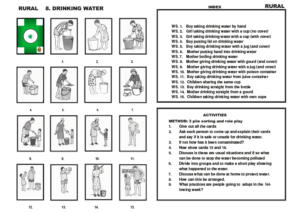Taking drinking water
Description of the Topic
‘Utilisation of Drinking Water’ provides 17 illustrations which reflect many common ways in which drinking water is consumed in many parts of Africa. The cards are used to help prompt participants to discuss some of the health challenges they may face, if they do not take care when drinking water.
How to use Card set 8.b. ‘Utilisation of Drinking Water’
This set can be used in three ways:
- A participant holds up the card to the audience and describes what she thinks is right or wrong with the way the person is drinking water.
- The cards can be used in conjunction with the card set 2.a. on Common Disease to test out people’s knowledge of which diseases can be prevented by ensuring drinking water is safe to consume.
- This card set can be used together with 7.a. ‘Water Sources’ and 8.a. ‘Storage of Drinking Water’ to show how all three stages of water consumption must be hygienic if water is to be safe to drink.
Link to the Facilitator instructions for the topic
LIST OF ILLUSTRATED CARDS
ENGLISH FRENCH
| 1 | Dog drinking straight from uncovered bucket (bad) | Chien buvant directement du seau non couvert (mauvais) |
| 2 | Boy drinking straight from stream, using hands (bad) | Garçon buvant directement du ruisseau, utilisant des mains (mauvais) |
| 3 | Boy drinking straight from handpump, using hands (bad) | Garçon buvant directement de pompe, utilisant des mains (mauvais) |
| 4 | Boy drinking from plastic bottle which had contained a dangerous chemical (bad) | Garçon buvant de la bouteille en plastique qui avait contenu un produit chimique dangereux (mauvais) |
| 5 | Boy drinking from a container which was a fruit juice bottle (medium) | Garçon buvant d’un récipient qui était une bouteille de jus de fruit (moyen) |
| 6 | Boy drinking straight from bucket / jug (bad) | Garçon buvant directement de seau/cruche (mauvais) |
| 7 | Man polluting water by putting hand in water (bad) | L’homme pollue l’eau en mettant la main dans l’eau (mauvais) |
| 8 | Mother giving child water with ladle (not good) | Mère donnant l’eau d’enfant avec la louche (pas bonne) |
| 9 | Mother giving water with jug (correct) | Mère donnant l’eau avec la cruche (correcte) |
| 10 | Mother boiling unsafe drinking water (good) | Mère bouillante eau potable insalubre (bon) |
| 11 | Mother filtering water with clean cloth (good) | Eau de filtrage de mère avec le tissu propre (bon) |
| 12 | Mother using a water filter (good) | Mère utilisant un filtre à eau (bon) |
| 13 | Use of Chlorine Product (Jik / Sur l’Eau) (good) | Utilisation de produits chlorés (jik/sur l’eau) (bon) |
| 14 | Children Sharing cups (not good) | Enfants partageant des tasses (pas bon) |
| 15 | Children with their own individual cups (good) | Enfants avec leurs propres tasses individuelles (bon) |
| 16 | Men sharing straws when drinking (not good) | Hommes partageant des pailles en buvant (pas bon) |
| 17 | Mother taking water from jerry can with lid (good) | Mère prenant l’eau de Jerry peut avec le couvercle (bon) |
Facilitator instructions for Drinking Water (Rural) in English:

